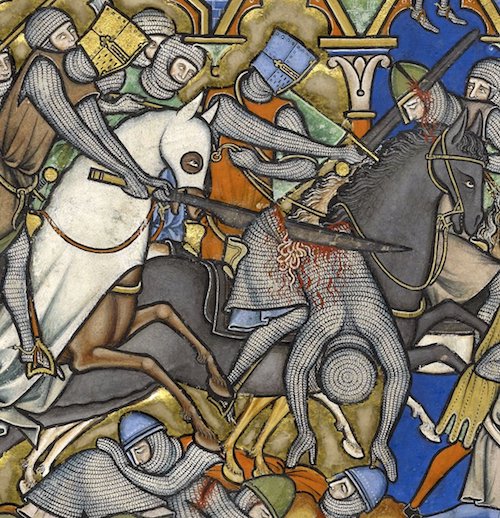We run our website the way we wished the whole internet worked: we provide high quality original content with no ads. We are funded solely by your direct support. Please consider supporting this project.

The Violent “Church Triumphant”
In light of how central enemy-loving non-violence is to Jesus’ teaching and to his cross-centered revelation of God, we have to wonder why the church has refused to listen to its head and instead condoned violence, as pointed out in the previous post? Christian theologians have used OT’s violent portraits of God, at least since fourth century to promote the use of violence. For example, how could Luther have failed to wrestle with the violent portraits of the Old Testament when he claimed to “see nothing in Scripture except Christ crucified”?
For the first three centuries of church history, theologians such as Origen found non-literal ways of interpreting the OT’s violent divine portraits so that they could not be used to promote violence. Christians during this period took seriously Jesus’ call to refrain from violence and to love and serve enemies. However beginning in the early fourth century, the church began to undergo a massive transformation.
It began when a Roman emperor named Constantine allegedly had a vision just before a major battle he was going to fight. This vision convinced him that he and his army would defeat their foes if he fought under the banner of Christ. This was the first (but unfortunately hardly the last) time the name of Jesus Christ was associated with violence. Constantine won the battle, and since pagans have always assumed that military victories reveal which army has the stronger god, Constantine decided to pledge his allegiance to Christ. However, his version of Christ was a triumphant pagan warrior deity rather than as the self-sacrificial loving Savior.
Constantine legalized Christianity in 313 A.D. and he showered the Church with wealth and political power. In the span of less than a century, the Church went from being a despised and persecuted minority within the Roman Empire to the official religion of the Roman Empire, making it illegal for everyone except Jews not to be a Christian. And since the religion of Rome had always played an important role in the running of the State, the Church began to play this role.
However, it’s impossible to play any role in running the Roman Empire (or any other empire for that matter) if you’re not willing to use the sword to preserve law and order and to protect the State from threatening foes. So, not surprisingly, in the fourth and fifth centuries we find Christian theologians like St. Augustine going to extreme lengths to try to justify the use of violence, despite the NT’s clear teachings to the contrary.
Whereas the persecuted Church of the first three centuries believed it was called to refrain from violence and serve the world by carrying the cross, the politically-empowered Church of the fourth and fifth centuries began to believe it was called to conquer the world for Christ, wielding the sword when necessary. The persecuted Church became the persecuting “Church Triumphant,” since it now had the political authority to persecute heretics and unbelievers. The Empire of Rome was retitled “the holy Roman Empire,” and Christ was believed to be its triumphant Emperor. “Christendom” was born, and while this religion has (thankfully) been dying for the last several hundred years, it has, for all intents and purposes, been the face of Christianity for the last fifteen hundred years.
As Christendom was coming into being, and Christians acclimated to the use of violence, the OT’s violent depictions of God became much less problematic. Indeed, it became advantageous at this time to interpret these portraits literally. Christendom’s leaders could appeal to them when they needed to justify their use of violence and when they needed to motivate Christians to engage in violence on behalf of their “Christian” Empire. Tragically, these violent portraits have been serving this function ever since.
Image: Fatality, ‘Maciejowski Bible’, Paris ca. 1240 (NY, Morgan Library & Museum, MS M.638, fol. 10v)
Category: General
Tags: Augustine, Constantine, Cruciform Theology, Jesus, Violence
Topics: Enemy-Loving Non-Violence, The Church
Related Reading

Jesus’ Different Kind of Nation
God called Abraham to form a unique nation by which “all peoples of the earth will be blessed.” The unique call of the descendants of Abraham was to become a nation of servant-priests whom God would use to reunite the nations of the world under his loving Lordship. The vision of a reunited humanity is…

Isn’t the Resurrection the Ultimate Revelation of God? (podcast)
Greg considers the relationship between Christ’s death and resurrection. http://traffic.libsyn.com/askgregboyd/Episode_0744.mp3

Finding an Alternative Jesus
The “Newly Discovered” Jesus One of the most common, and most disturbing, refrains heard in the media’s coverage of contemporary radical views of Christ is that New Testament scholars have recently “discovered” new sources of information about Jesus that contradict the Bible’s own view of Jesus. It is claimed that works such as the Gospel…

The Cruciform Trinity
As paradoxical as it sounds, if God is supremely revealed when he stoops to the infinite extremity of becoming his own antithesis on the cross, then we must conclude that stooping to this extremity out of love must, in some sense, be intrinsic to who God eternally is. And rendering this coherent necessitates that we…

The Bible is Infallible NOT Inerrant
While the cruciform understanding (explained here) of the “God-breathed” nature of Scripture is in tension with the way most talk about inerrancy (See previous post on inerrancy), I do not believe it is at all incompatible with what the Church has always sought to express by affirming the “infallibility” the Scripture. The core conviction is that Scripture will…

God Became a Zygote
Has the Christmas story become so familiar that you’ve lost any sense of how spectacular it is? The great creator of the universe became a microscopic zygote. The all-powerful being who spoke the stars into existence came in a very small and vulnerable way. He crossed an infinite distance to become one of us. You can watch…
